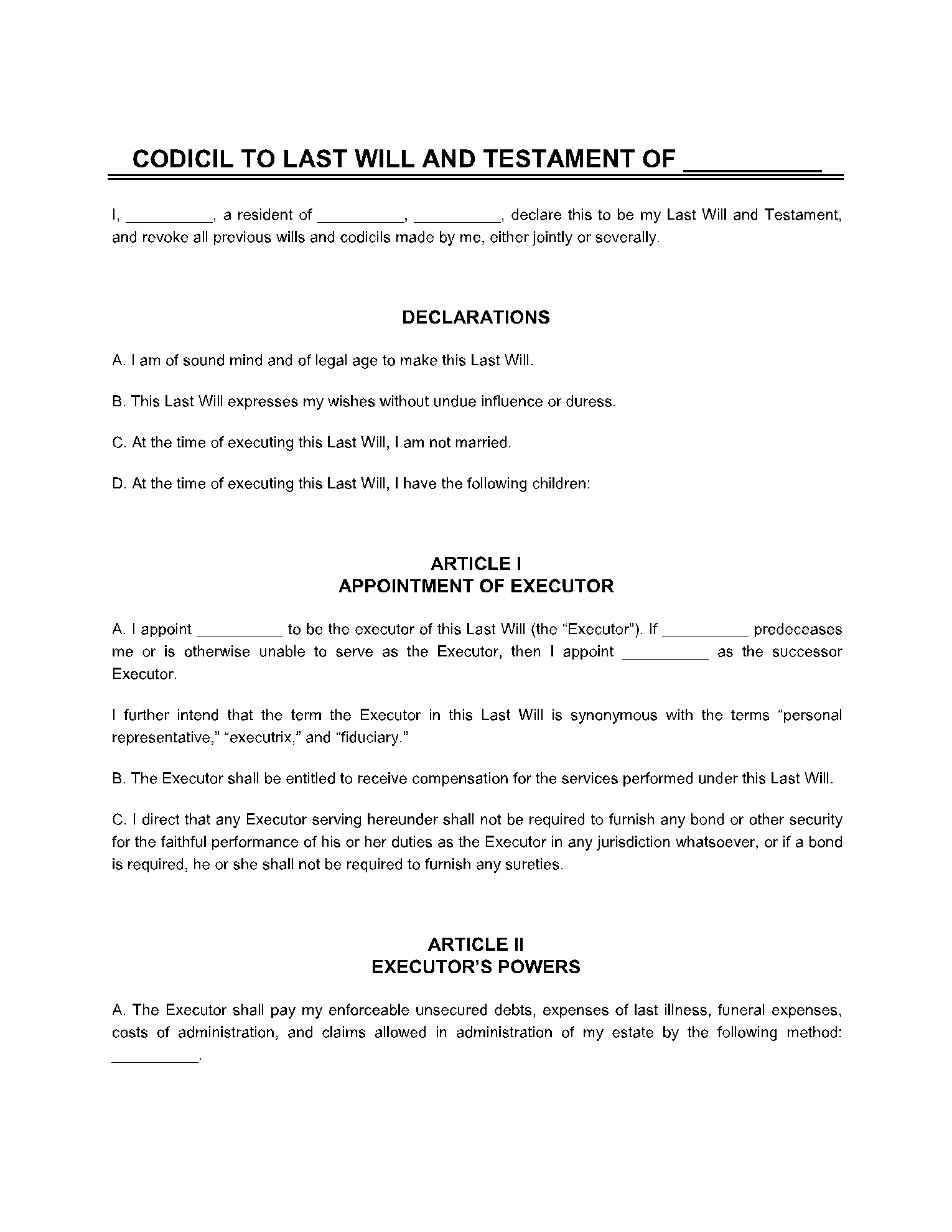After writing a final will and testament, some people decide they want to amend a small portion of it. It's possible that their family has grown to include new members. Perhaps their assets have grown to include a special heirloom that they want to pass on to a descendant.
When this occurs, and you just need to make a few small changes, a simple codicil to will normally work instead of rewriting the whole will. A codicil form is a separate document that modifies a will's original provisions. This article goes through the basics of a codicil form, including what it is and how to write one if it is needed.
What Is a Codicil to Will Form?
A codicil to a will allows you to make changes to your will without writing a new one. A will codicil form is a written document that explains how to amend the will specifically. For instance, you can use the free codicil form to change the executor or appoint a new one. Similarly, you can also use it to bequeath a particular object to someone who wasn't named in your original will.
Codicil forms aren't used almost as much as they were in the past. Wills used to be written by hand, and any slight alteration required painstakingly rewriting the entire text. Codicils made it easier to change the terms of a will. Even when wills were written on typewriters, this was still the case.
You must, however, follow a particular process to establish a codicil and bind it to your will, just as you would for the last will and testament form or a living will.
How Do I Draft a Codicil to a Will Online?
It is not difficult to write a codicil, but it must be done correctly. We'll walk you through the steps, but state law can vary and necessitate a different codicil template. The state specifications will be known to your lawyer, or you can download a blank codicil form template that is unique to your state. Blank codicil forms are typically simple to complete and can be a good place to start.
If you already have a legal representative, they may also advise you on how to write a will codicil. Alternatively, you may use the free codicil form to generate a printable codicil to will. You may make digital edits and modifications, then print them out easily before signing with witnesses.
Even if you're consulting with a lawyer, the codicil to will template makes things more straightforward because you'll start with a better understanding of what you want to change by writing those changes down and then working on the legal phrasing.
- Make changes to your will by finding a current copy of your will.
If you intend to make more than one change to your current last will and testament, the first move should always be to review it. Before you start writing a codicil form, go through every clause because the more changes you make, the more likely your lawyer will advise you to write a new will instead.
- Compose a codicil
The testator's name and address, the author of the will and specified assets, the date the will was produced, and the declaration or amendments to the will are all included in all codicils to the will template.
You should probably seek legal advice at some point during this process, particularly if you plan to make more than a few changes. A law firm will help you determine if you need a codicil to will or a new last will and testament by advising you on the right terminology to use.
- Sign the Codicil in the Presence of Witnesses
Codicils, like wills, must be signed in the presence of at least two witnesses. The testator must sign in front of the witnesses, who cannot be beneficiaries mentioned in the will. After the codicil to will is signed, the witnesses must also approve it.
A self-proving affidavit requires witnesses to swear under oath that they saw the testator sign the will codicil form. To be considered legitimate, self-proving affidavits often require the presence of a notary public.
- Attach the Will to the codicil
The final move is to bind the signed and witnessed codicil to will and distribute copies of both documents to those who need to know, who are usually family members. Ensure that your lawyer has a current copy of both the will and the codicil for safekeeping.
Conclusion
A codicil form, which acts as a substitute, may be used for various things, including adding or eliminating beneficiaries and distributing associated estates. Since the free codicil form includes descriptions of the section that has changed, it is presumed that the most recent will contain all of the remaining required provisions.
These records will also assist you in upholding the quality of your will at all times. With the changes you go through in your life, you can add changes to your will through a codicil form. You may issue a codicil form to add or clarify terminology if you're getting married or having a child, or even if you just want to clarify a specific clause.
